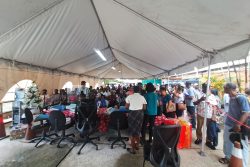Dear Editor,
It has oft been remarked that “there are three kinds of lies: lies, damned lies and statistics.” The pronouncements by the government, following the publication of the National Grade Six Assessment (NGSA) results, pirouetted on that third pillar. The dubious hot takes came from officials at the Ministry of Education, notably the acting Minister of Education, Ms Nicolette Henry and the Chief Education Officer, Mr. Marcel Hutson.
Commenting on the skyrocketing pass rates in Mathematics, which saw a more than threefold increase from 14% in 2016 to 45% this year, both Mr Hutson and Ms Henry breathlessly credited the government’s Emer-gency Mathematical Intervention Plan (EMIP), a $48 million dollar programme to bolster mathematics proficiency in public schools, especially at the sixth grade level. The strategy, according to a Guyana Chronicle report, involved “the training of teachers in content and methodology; facilitating fortnightly cluster meetings in all regions; the recruitment of Mathematics coordinators and monitors; the training of officers and school administrators to supervise the teaching of Mathematics; the preparing and administering of a diagnostic assessment of pupils in the hinterland regions before training; the enhancement of public relations, parental involvement in the education of the children and the acquisition of support materials for the students.”
Additionally, the strategy was accompanied by the development and deployment of an app, which provided students with access to practice questions along with instructional material. While at face value, the strategy is not altogether a bad idea, it appears that officials might have overstated its role in the surge in the Mathematics pass rates. More skeptical observers, your correspondent included, took to social media to marvel at the near miraculous 340% increase in sixth grade Mathematics proficiency in a period of 365 days. It soon emerged that there might be another factor behind the jaw dropping increase: this year’s examination might have been significantly less difficult than last year’s.
As Ms. Priya Manickchand, former Minister of Education, explained in a comment on Facebook, the Caribbean Examinations Council had set last year’s Mathematics exam, but with “no supervision of that process”, and, as such, the exam “contained questions that tested content not taught in the national program in Guyana [and]…tested critical thinking more than it was ever tested here and far more than children and their teachers were prepared for.” Ms. Manickchand went on to add that this year the process changed, with there being more local supervision of CXC’s setting of the Mathematics examination, and with the questions set “more in keeping with how our papers were historically set here.” “Additionally,” the former Minister and current Member of Parliament for the Opposition noted, “teachers have begun to learn to teach critical thinking, for which they are being monitored.”
To be fair, the problem of the NGSA’s Mathematics exam being a flawed gauge of gains or losses in Mathematics proficiency year-on-year is one the government has inherited. Statistics publicly provided by Mr. Gordon Moseley, journalist and owner of the online media outlet News Source, showed that for the years 2013, 2014, 2015, 2016, and 2017, the Mathematics pass rates were 43.9%, 31%, 37%, 13% and 45% respectively. The average pass rate over that period is 33.98 ± 13%. Even if we exclude 2016’s pass rate as an anomaly – as would be appropriate – the average is 39.23 ± 6.5 %. What those statistics say is that the pass rates are swinging wildly from year to year and in a country where politics is stable and policy is stagnant, these swings could reflect inconsistency in the toughness of the questions being put forth.
In fact, Ms. Manickchand explained, it was the problem of “fluctuating levels of difficulty” that led to CXC being engaged in the setting of the exams in the first place. Ms Manickchand also hinted that involving CXC in the exam setting process was a measure to insulate the exams from the political incentive to make them easier, thereby artificially boosting the pass rates which would in turn reflect positively on the incumbent.
It would be remiss of any observer to not acknowledge the hard work done daily by the men and women in the classrooms and the Ministry of Education to improve the lives and prospects of the nation’s students.
However, it is of tremendous disservice to their efforts as well as those of parents, students and all the other taxpayers, when politicians, with no strong evidentiary basis, overstate the efficacy of any one programme because doing so makes them look good.
And while none of what has been written here is to be taken as a definite conclusion as to what would have caused the Math pass rates to more than treble, the question as to what did remains to be answered empirically and honestly.
Yours faithfully,
Saieed I. Khalil





